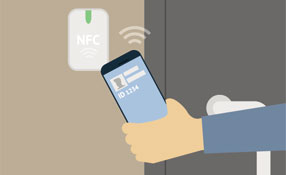 |
| More efficient event-driven video surveillance can be achieved by replacing VCA with physical detection |
Event-driven video for surveillance and recording involves using a video recorder or video management software system that is triggered by movement in the areas where cameras are located. Event-driven video can be achieved by using intelligent motion detection or video contents analytics (VCA) on the camera, recorder or PC server. Recently, performance of VCA has improved; however, some conditions can still affect detection using the camera image. Tomo Ito, Business Development Manager, Product and Business Planning Department for Optex, explains that sometimes it is difficult to obtain reliable detection for high-quality video surveillance or event-driven video recording, especially in conditions such as:
- Extreme darkness at night
- Movement of insects on the dome or lens of cameras
- Swaying vegetation blown by the wind
- Change of weather, such as sudden shift from sunshine into cloud.
In outdoor use, especially, there are many factors that affect the detection performance. Even if there are no intrusions, the images from a single camera can change every hour due to weather conditions, e.g. change the position of sun, shadow and cloud.
In such cases, more efficient event-driven video surveillance can be achieved by replacing VCA with physical detection or by using multiple detection technologies.
The marketplace includes many technologies for physical detectors. They offer various detection principles, advantages and disadvantages. Of course, manufacturers of physical detectors have sought to improve on the disadvantages. Following are some general descriptions. Incorporating sensors requires additional installation of an external device to the video system, but it provides more reliable detection performance using detectors suitable to site conditions.
Passive Infrared (PIR) Detectors
PIRs can detect the temperature gap between a moving object and the background in a detection area. The design of optics can shape and define detection areas. A narrow or wide volumetric detection area can be created, and a detector offering the proper detection area should be installed at a site needing protection. This technology does not rely on the quality of the camera image or brightness at the site. By using a different technology, the false alarm or missing alarm rate can be reduced. Meanwhile, if the surface temperatures of the intruder and background (e.g., the ground) are the same, the detector cannot be triggered. Also, if there is sudden temperature change in the detection area due to weather conditions (e.g., sudden heavy rain and strong), a false alarm can result. A unique point is that short-range PIR detectors can be installed and adjusted easily. The price range may be the most reasonable among other technologies.
Market leaders who provide video security devices are incorporating physical detectors to trigger the video system to start recording, to change recording frame rate or to direct PTZ positions for efficient video surveillance or recording |
Some camera products accommodate PIR sensors. For outdoor use, adequate detection range and more reliable detection suggest use of these separate physical detectors. Benefits are more similar to server-based VCA compared to camera-based VCA.
Photoelectric Detectors
An infrared (IR) light source generates a pulsed IR beam that is detected by an IR receiver. The transmitter and receiver are installed on opposite sides of an area to be monitored. The receiver detects when the pulsed beam is physically interrupted by an intruder, and then generates alarms. A photoelectric detector can create multiple stacking beam patterns. The detection area pattern is point-to-point (line protection), like a real trip wire. Only an intruder going through the protection line can create an alarm. A disadvantage is that an object moving too fast can be missed. Also, growing vegetation can block the beam path, thus resulting in a false alarm.
Laser Scan Detectors
A new technology in the market, line scan detectors use TOF (time of flight) technology to precisely calculate the distance between an object and the detector unit. A scanning mechanism spins very fast to enable high-resolution sensing to recognize the size of an object, its moving distance and moving speed. Therefore, it can detect both a human being and also recognize the intrusion point precisely, which can be used to direct the view of a pan-tilt-zoom (PTZ) camera. The detection area is funnel-shaped. Depending on the manufacturer, some products can create very precise detection areas, set by PC software. The precise detection area settings and reliable detection performance are big advantages, although the price range may be higher than other detectors. Generally fog, heavy rain and snow can affect detection performance.
Fiber Detectors
Fiber-sensing cable is combined with an alarm processor unit that continually interrogates the sensor by transmitting laser light through the fiber cable. Motion, pressure or vibration from an intruder causes a detectable shift in the pattern of transmitted light in the fiber-sensing cable. The alarm processor unit can detect the pattern change and create alarms. fibercable should be mounted directly on the fence fabric. A high-quality and stable fence installation is necessary for reliable detection. Poor fence quality (stability) is the most common cause of unreliable detection. This technology is impervious to transient voltage from lightning strikes, radio frequency interference (RFI) and electro-magnetic interference (EMI).
Market leaders who provide video security devices are incorporating physical detectors to trigger the video system to start recording, to change recording frame rate or to direct PTZ positions for efficient video surveillance or recording.
 |
| Highly reliable detection works to reduce the bandwidth issue as “Smart Video Activation” |
The video security market continues to experience a technology transition from analog CCTV video systems to more sophisticated network-based IP video solutions. IP video solutions use network-based video management software that can efficiently collect, manage, and analyze large amounts of video over networks. However, a new issue occurs – heavy traffic on the network. High-quality video surveillance requires wide bandwidth on the network. Without solving this factor, higher resolution video surveillance cannot be achieved.
By using external physical detectors that do not rely on the quality of the camera image, false alarms can be reduced sharply in bright or dark conditions. Detectors can be installed at the points to be protected, and the intrusion points can be easily recognized to trigger the system.
Recently, detectors can also accommodate a wireless signal transmitter and analog/IP encoder unit for IP connection. These options are good solutions for easy and flexible installation, relocation and simple cabling.
Highly reliable detection can reduce false alarms, which contributes to more efficient video surveillance applications, including local and remote video monitoring. It also works to reduce the bandwidth issue as “Smart Video Activation.” Detection can contribute to more efficient video security.
-300.jpg)





















